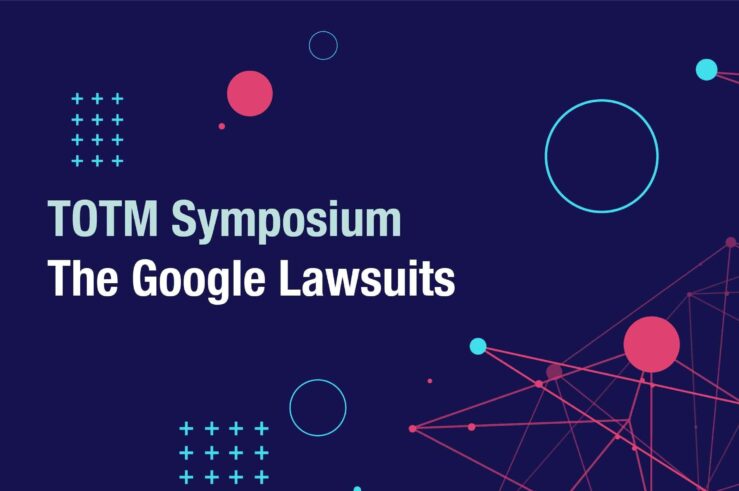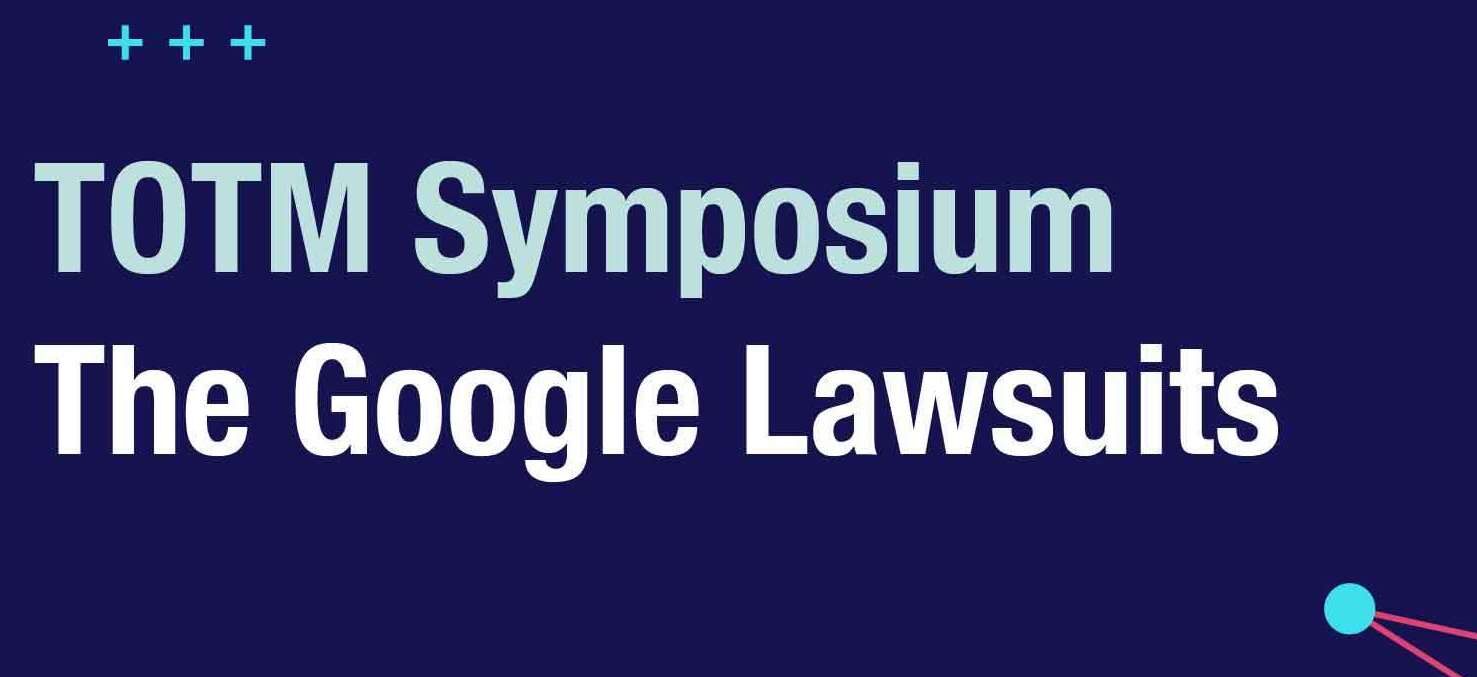
This article is a part of the Symposium on the Future of American Antitrust: The Google Lawsuits symposium.

The U.S. Department of Justice’s (DOJ) antitrust case against Google, which was filed in October 2020, will be a tough slog.[1] It is an alleged monopolization (Sherman Act, Sec. 2) case; and monopolization cases are always a tough slog.
In this brief essay I will lay out some of the issues in the case and raise an intriguing possibility.
What is the case about?
The case is about exclusivity and exclusion in the distribution of search engine services; that Google paid substantial sums to Apple and to the manufacturers of Android-based mobile phones and tablets and also to wireless carriers and web-browser proprietors—in essence, to distributors—to install the Google search engine as the exclusive pre-set (installed), default search program. The suit alleges that Google thereby made it more difficult for other search-engine providers (e.g., Bing; DuckDuckGo) to obtain distribution for their search-engine services and thus to attract search-engine users and to sell the online advertising that is associated with search-engine use and that provides the revenue to support the search “platform” in this “two-sided market” context.[2]
Exclusion can be seen as a form of “raising rivals’ costs.”[3] Equivalently, exclusion can be seen as a form of non-price predation. Under either interpretation, the exclusionary action impedes competition.
It’s important to note that these allegations are different from those that motivated an investigation by the Federal Trade Commission (which the FTC dropped in 2013) and the cases by the European Union against Google.[4] Those cases focused on alleged self-preferencing; that Google was unduly favoring its own products and services (e.g., travel services) in its delivery of search results to users of its search engine. In those cases, the impairment of competition (arguably) happens with respect to those competing products and services, not with respect to search itself.
What is the relevant market?
For a monopolization allegation to have any meaning, there needs to be the exercise of market power (which would have adverse consequences for the buyers of the product). And in turn, that exercise of market power needs to occur in a relevant market: one in which market power can be exercised.
Here is one of the important places where the DOJ’s case is likely to turn into a slog: the delineation of a relevant market for alleged monopolization cases remains as a largely unsolved problem for antitrust economics.[5] This is in sharp contrast to the issue of delineating relevant markets for the antitrust analysis of proposed mergers. For this latter category, the paradigm of the “hypothetical monopolist” and the possibility that this hypothetical monopolist could prospectively impose a “small but significant non-transitory increase in price” (SSNIP) has carried the day for the purposes of market delineation.
But no such paradigm exists for monopolization cases, in which the usual allegation is that the defendant already possesses market power and has used the exclusionary actions to buttress that market power. To see the difficulties, it is useful to recall the basic monopoly diagram from Microeconomics 101. A monopolist faces a negatively sloped demand curve for its product (at higher prices, less is bought; at lower prices, more is bought) and sets a profit-maximizing price at the level of output where its marginal revenue (MR) equals its marginal costs (MC). Its price is thereby higher than an otherwise similar competitive industry’s price for that product (to the detriment of buyers) and the monopolist earns higher profits than would the competitive industry.
But unless there are reliable benchmarks as to what the competitive price and profits would otherwise be, any information as to the defendant’s price and profits has little value with respect to whether the defendant already has market power. Also, a claim that a firm does not have market power because it faces rivals and thus isn’t able profitably to raise its price from its current level (because it would lose too many sales to those rivals) similarly has no value. Recall the monopolist from Micro 101. It doesn’t set a higher price than the one where MR=MC, because it would thereby lose too many sales to other sellers of other things.
Thus, any firm—regardless of whether it truly has market power (like the Micro 101 monopolist) or is just another competitor in a sea of competitors—should have already set its price at its profit-maximizing level and should find it unprofitable to raise its price from that level.[6] And thus the claim, “Look at all of the firms that I compete with! I don’t have market power!” similarly has no informational value.
Let us now bring this problem back to the Google monopolization allegation: What is the relevant market? In the first instance, it has to be “the provision of answers to user search queries.” After all, this is the “space” in which the exclusion occurred. But there are categories of search: e.g., search for products/services, versus more general information searches (“What is the current time in Delaware?” “Who was the 21st President of the United States?”). Do those separate categories themselves constitute relevant markets?
Further, what would the exercise of market power in a (delineated relevant) market look like? Higher-than-competitive prices for advertising that targets search-results recipients is one obvious answer (but see below). In addition, because this is a two-sided market, the competitive “price” (or prices) might involve payments by the search engine to the search users (in return for their exposure to the lucrative attached advertising).[7] And product quality might exhibit less variety than a competitive market would provide; and/or the monopolistic average level of quality would be lower than in a competitive market: e.g., more abuse of user data, and/or deterioration of the delivered information itself, via more self-preferencing by the search engine and more advertising-driven preferencing of results.[8]
In addition, a natural focus for a relevant market is the advertising that accompanies the search results. But now we are at the heart of the difficulty of delineating a relevant market in a monopolization context. If the relevant market is “advertising on search engine results pages,” it seems highly likely that Google has market power. If the relevant market instead is all online U.S. advertising (of which Google’s revenue share accounted for 32% in 2019[9]), then the case is weaker; and if the relevant market is all advertising in the United States (which is about twice the size of online advertising[10]), the case is weaker still. Unless there is some competitive benchmark, there is no easy way to delineate the relevant market.[11]
What exactly has Google been paying for, and why?
As many critics of the DOJ’s case have pointed out, it is extremely easy for users to switch their default search engine. If internet search were a normal good or service, this ease of switching would leave little room for the exercise of market power. But in that case, why is Google willing to pay $8-$12 billion annually for the exclusive default setting on Apple devices and large sums to the manufacturers of Android-based devices (and to wireless carriers and browser proprietors)? Why doesn’t Google instead run ads in prominent places that remind users how superior Google’s search results are and how easy it is for users (if they haven’t already done so) to switch to the Google search engine and make Google the user’s default choice?
Suppose that user inertia is important. Further suppose that users generally have difficulty in making comparisons with respect to the quality of delivered search results. If this is true, then being the default search engine on Apple and Android-based devices and on other distribution vehicles would be valuable. In this context, the inertia of their customers is a valuable “asset” of the distributors that the distributors may not be able to take advantage of, but that Google can (by providing search services and selling advertising). The question of whether Google’s taking advantage of this user inertia means that Google exercises market power takes us back to the issue of delineating the relevant market.
There is a further wrinkle to all of this. It is a well-understood concept in antitrust economics that an incumbent monopolist will be willing to pay more for the exclusive use of an essential input than a challenger would pay for access to the input.[12] The basic idea is straightforward. By maintaining exclusive use of the input, the incumbent monopolist preserves its (large) monopoly profits. If the challenger enters, the incumbent will then earn only its share of the (much lower, more competitive) duopoly profits. Similarly, the challenger can expect only the lower duopoly profits. Accordingly, the incumbent should be willing to outbid (and thereby exclude) the challenger and preserve the incumbent’s exclusive use of the input, so as to protect those monopoly profits.
To bring this to the Google monopolization context, if Google does possess market power in some aspect of search—say, because online search-linked advertising is a relevant market—then Google will be willing to outbid Microsoft (which owns Bing) for the “asset” of default access to Apple’s (inertial) device owners. That Microsoft is a large and profitable company and could afford to match (or exceed) Google’s payments to Apple is irrelevant. If the duopoly profits for online search-linked advertising would be substantially lower than Google’s current profits, then Microsoft would not find it worthwhile to try to outbid Google for that default access asset.
Alternatively, this scenario could be wholly consistent with an absence of market power. If search users (who can easily switch) consider Bing to be a lower-quality search service, then large payments by Microsoft to outbid Google for those exclusive default rights would be largely wasted, since the “acquired” default search users would quickly switch to Google (unless Microsoft provided additional incentives for the users not to switch).
But this alternative scenario returns us to the original puzzle: Why is Google making such large payments to the distributors for those exclusive default rights?
An intriguing possibility
Consider the following possibility. Suppose that Google was paying that $8-$12 billion annually to Apple in return for the understanding that Apple would not develop its own search engine for Apple’s device users.[13] This possibility was not raised in the DOJ’s complaint, nor is it raised in the subsequent suits by the state attorneys general.
But let’s explore the implications by going to an extreme. Suppose that Google and Apple had a formal agreement that—in return for the $8-$12 billion per year—Apple would not develop its own search engine. In this event, this agreement not to compete would likely be seen as a violation of Section 1 of the Sherman Act (which does not require a market delineation exercise) and Apple would join Google as a co-conspirator. The case would take on the flavor of the FTC’s prosecution of “pay-for-delay” agreements between the manufacturers of patented pharmaceuticals and the generic drug manufacturers that challenge those patents and then receive payments from the former in return for dropping the patent challenge and delaying the entry of the generic substitute.[14]
As of this writing, there is no evidence of such an agreement and it seems quite unlikely that there would have been a formal agreement. But the DOJ will be able to engage in discovery and take depositions. It will be interesting to find out what the relevant executives at Google—and at Apple—thought was being achieved by those payments.
What would be a suitable remedy/relief?
The DOJ’s complaint is vague with respect to the remedy that it seeks. This is unsurprising. The DOJ may well want to wait to see how the case develops and then amend its complaint.
However, even if Google’s actions have constituted monopolization, it is difficult to conceive of a suitable and effective remedy. One apparently straightforward remedy would be to require simply that Google not be able to purchase exclusivity with respect to the pre-set default settings. In essence, the device manufacturers and others would always be able to sell parallel default rights to other search engines: on the basis, say, that the default rights for some categories of customers—or even a percentage of general customers (randomly selected)—could be sold to other search-engine providers.
But now the Gilbert-Newbery insight comes back into play. Suppose that a device manufacturer knows (or believes) that Google will pay much more if—even in the absence of any exclusivity agreement—Google ends up being the pre-set search engine for all (or nearly all) of the manufacturer’s device sales, as compared with what the manufacturer would receive if those default rights were sold to multiple search-engine providers (including, but not solely, Google). Can that manufacturer (recall that the distributors are not defendants in the case) be prevented from making this sale to Google and thus (de facto) continuing Google’s exclusivity?[15]
Even a requirement that Google not be allowed to make any payment to the distributors for a default position may not improve the competitive environment. Google may be able to find other ways of making indirect payments to distributors in return for attaining default rights, e.g., by offering them lower rates on their online advertising.
Further, if the ultimate goal is an efficient outcome in search, it is unclear how far restrictions on Google’s bidding behavior should go. If Google were forbidden from purchasing any default installation rights for its search engine, would (inert) consumers be better off? Similarly, if a distributor were to decide independently that its customers were better served by installing the Google search engine as the default, would that not be allowed? But if it is allowed, how could one be sure that Google wasn’t indirectly paying for this “independent” decision (e.g., through favorable advertising rates)?
It’s important to remember that this (alleged) monopolization is different from the Standard Oil case of 1911 or even the (landline) AT&T case of 1984. In those cases, there were physical assets that could be separated and spun off to separate companies. For Google, physical assets aren’t important. Although it is conceivable that some of Google’s intellectual property—such as Gmail, YouTube, or Android—could be spun off to separate companies, doing so would do little to cure the (arguably) fundamental problem of the inert device users.
In addition, if there were an agreement between Google and Apple for the latter not to develop a search engine, then large fines for both parties would surely be warranted. But what next? Apple can’t be forced to develop a search engine.[16] This differentiates such an arrangement from the “pay-for-delay” arrangements for pharmaceuticals, where the generic manufacturers can readily produce a near-identical substitute for the patented drug and are otherwise eager to do so.
At the end of the day, forbidding Google from paying for exclusivity may well be worth trying as a remedy. But as the discussion above indicates, it is unlikely to be a panacea and is likely to require considerable monitoring for effective enforcement.
Conclusion
The DOJ’s case against Google will be a slog. There are unresolved issues—such as how to delineate a relevant market in a monopolization case—that will be central to the case. Even if the DOJ is successful in showing that Google violated Section 2 of the Sherman Act in monopolizing search and/or search-linked advertising, an effective remedy seems problematic. But there also remains the intriguing question of why Google was willing to pay such large sums for those exclusive default installation rights?
The developments in the case will surely be interesting.
[1] The DOJ’s suit was joined by 11 states. More states subsequently filed two separate antitrust lawsuits against Google in December.
[2] There is also a related argument: That Google thereby gained greater volume, which allowed it to learn more about its search users and their behavior, and which thereby allowed it to provide better answers to users (and thus a higher-quality offering to its users) and better-targeted (higher-value) advertising to its advertisers. Conversely, Google’s search-engine rivals were deprived of that volume, with the mirror-image negative consequences for the rivals. This is just another version of the standard “learning-by-doing” and the related “learning curve” (or “experience curve”) concepts that have been well understood in economics for decades.
[3] See, for example, Steven C. Salop and David T. Scheffman, “Raising Rivals’ Costs: Recent Advances in the Theory of Industrial Structure,” American Economic Review, Vol. 73, No. 2 (May 1983), pp. 267-271; and Thomas G. Krattenmaker and Steven C. Salop, “Anticompetitive Exclusion: Raising Rivals’ Costs To Achieve Power Over Price,” Yale Law Journal, Vol. 96, No. 2 (December 1986), pp. 209-293.
[4] For a discussion, see Richard J. Gilbert, “The U.S. Federal Trade Commission Investigation of Google Search,” in John E. Kwoka, Jr., and Lawrence J. White, eds. The Antitrust Revolution: Economics, Competition, and Policy, 7th edn. Oxford University Press, 2019, pp. 489-513.
[5] For a more complete version of the argument that follows, see Lawrence J. White, “Market Power and Market Definition in Monopolization Cases: A Paradigm Is Missing,” in Wayne D. Collins, ed., Issues in Competition Law and Policy. American Bar Association, 2008, pp. 913-924.
[6] The forgetting of this important point is often termed “the cellophane fallacy”, since this is what the U.S. Supreme Court did in a 1956 antitrust case in which the DOJ alleged that du Pont had monopolized the cellophane market (and du Pont, in its defense claimed that the relevant market was much wider: all flexible wrapping materials); see U.S. v. du Pont, 351 U.S. 377 (1956). For an argument that profit data and other indicia argued for cellophane as the relevant market, see George W. Stocking and Willard F. Mueller, “The Cellophane Case and the New Competition,” American Economic Review, Vol. 45, No. 1 (March 1955), pp. 29-63.
[7] In the context of differentiated services, one would expect prices (positive or negative) to vary according to the quality of the service that is offered. It is worth noting that Bing offers “rewards” to frequent searchers; see https://www.microsoft.com/en-us/bing/defaults-rewards. It is unclear whether this pricing structure of payment to Bing’s customers represents what a more competitive framework in search might yield, or whether the payment just indicates that search users consider Bing to be a lower-quality service.
[8] As an additional consequence of the impairment of competition in this type of search market, there might be less technological improvement in the search process itself – to the detriment of users.
[9] As estimated by eMarketer: https://www.emarketer.com/newsroom/index.php/google-ad-revenues-to-drop-for-the-first-time/.
[10] See https://www.visualcapitalist.com/us-advertisers-spend-20-years/.
[11] And, again, if we return to the du Pont cellophane case: Was the relevant market cellophane? Or all flexible wrapping materials?
[12] This insight is formalized in Richard J. Gilbert and David M.G. Newbery, “Preemptive Patenting and the Persistence of Monopoly,” American Economic Review, Vol. 72, No. 3 (June 1982), pp. 514-526.
[13] To my knowledge, Randal C. Picker was the first to suggest this possibility; see https://www.competitionpolicyinternational.com/a-first-look-at-u-s-v-google/. Whether Apple would be interested in trying to develop its own search engine – given the fiasco a decade ago when Apple tried to develop its own maps app to replace the Google maps app – is an open question. In addition, the Gilbert-Newbery insight applies here as well: Apple would be less inclined to invest the substantial resources that would be needed to develop a search engine when it is thereby in a duopoly market. But Google might be willing to pay “insurance” to reinforce any doubts that Apple might have.
[14] The U.S. Supreme Court, in FTC v. Actavis, 570 U.S. 136 (2013), decided that such agreements could be anti-competitive and should be judged under the “rule of reason”. For a discussion of the case and its implications, see, for example, Joseph Farrell and Mark Chicu, “Pharmaceutical Patents and Pay-for-Delay: Actavis (2013),” in John E. Kwoka, Jr., and Lawrence J. White, eds. The Antitrust Revolution: Economics, Competition, and Policy, 7th edn. Oxford University Press, 2019, pp. 331-353.
[15] This is an example of the insight that vertical arrangements – in this case combined with the Gilbert-Newbery effect – can be a way for dominant firms to raise rivals’ costs. See, for example, John Asker and Heski Bar-Isaac. 2014. “Raising Retailers’ Profits: On Vertical Practices and the Exclusion of Rivals.” American Economic Review, Vol. 104, No. 2 (February 2014), pp. 672-686.
[16] And, again, for the reasons discussed above, Apple might not be eager to make the effort.



